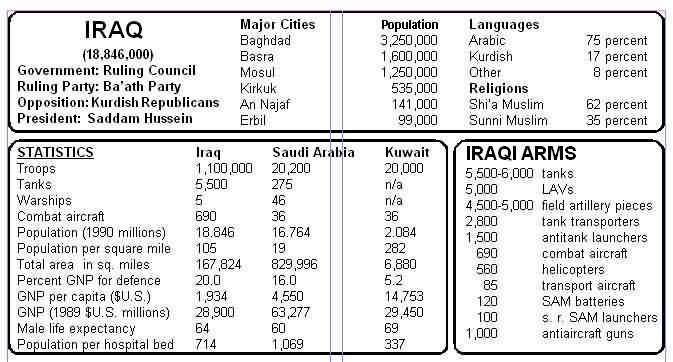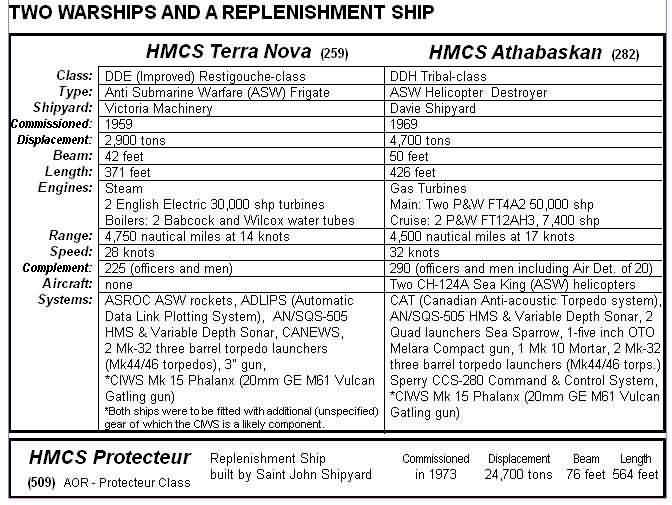![]() Home | Back to TWR Index | Email | The Editor | History | Gulf War
Index
Home | Back to TWR Index | Email | The Editor | History | Gulf War
Index
Special Report On "Operation Desert Shield"

![]()
Volume 4, Number 33 August 15, 1990
Why is there so much force? How is it that despite the enormous risk encumbent with amassing opposed armed forces in a `hot spot' like the Middle East, this man, Saddam Hussein can provoke that reaction? Could it simply be righteous indignation over the Iraqi invasion of Kuwait? Is it oil? Money? Power? Support for two of the United States' allies: Egypt and Saudi Arabia? Is it because of the threat of losing Saudi Arabia, and consequently 40 percent control of the world's oil resources to Hussein?
In aggregate, those are strong reasons, but could there be even more? Apart from a one-million-man army, chemical weapons, and a significant conventional weapons arsenal, what has Saddam Hussein got that has prompted the extensive military action by the West?
Tactical, nuclear weapons? If Iraq has them, nuclear war would have been imminent.
Apart from Saddam Hussein's indigenous nuclear programme to the absolute consternation of Moscow there are persistent rumours circulating through the Middle East about Soviet tactical nuclear weapons stolen by Islamic fundamentalists from a Soviet military facility near the Azerbaijan/Iran border last January.
As one account goes, during ethnic violence in the Nagorno Karabakh region, local guerillas swooped in on an "arms depot" near the city of Baku snatching up arms and equipment, and according to the tale, stole 8-9 dozen tactical nuclear weapons which since that time have been allegedly sold into the Third World.
On the night of Monday, January 15, shortly after the raid on the Soviet depot, Mikhail Gorbachev moved swiftly to send the Red Army into the region with the apparent moral support of Washington. The Soviet Presidium in Moscow declared a state of emergency and imposed martial law on the Azerbaijan's disputed Nagorno-Karabakh region and in nearby areas of Azerbaijan and the republic of Armenia. The Kremlin sent high-level troubleshooters into the region.
As Armenian and Azerbaijani civilians spilled each other's blood, were Soviet Army and KGB troops attempting to trace the movement of a horrifying plunder of tactical nuclear weapons?
Comment:
BEHIND "DESERT SHIELD"
The movement of troops to the Middle East is massive.
From the U.S. alone, if the present rate continues for another 7 days, there will be 211,000 or more troops on the ground in Saudi Arabia next Wednesday. Every ten minutes another aircraft — C-5s, C-130s, C-141s and commercial charters, "anything they can get their hands on" — leaves the U.S. for the Middle East. Some U.S. military operations tacticians are even looking at stripping commercial aircraft, creating large cargo holds to haul components for the Army's AH-64 Apaches, The Wednesday Report was told.
Dispatched by Pentagon leaders are the U.S. Army's XVIII Airborne Corps including the 82nd Airborne Division and the 101st Airborne Division (Air Assault); the entire 24th Mechanized Infantry Brigade; U.S. Marines; thousands of U.S. Air Force personnel; and the sailors and airmen of four carrier groups, USS Independence, USS Dwight D. Eisenhower, USS Saratoga; and most recently, USS John F. Kennedy.
American nuclear weapons are already present in the Gulf region aboard the fleet as is normal, and conceivably as one reliable source suggests, with ground forces in Saudi Arabia.

